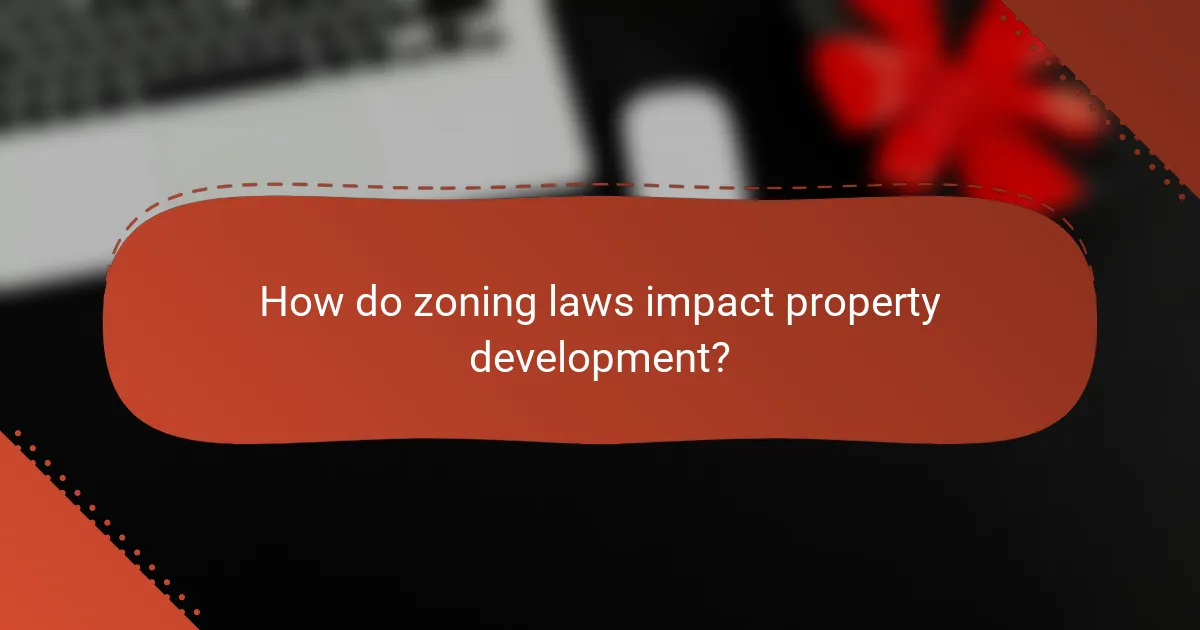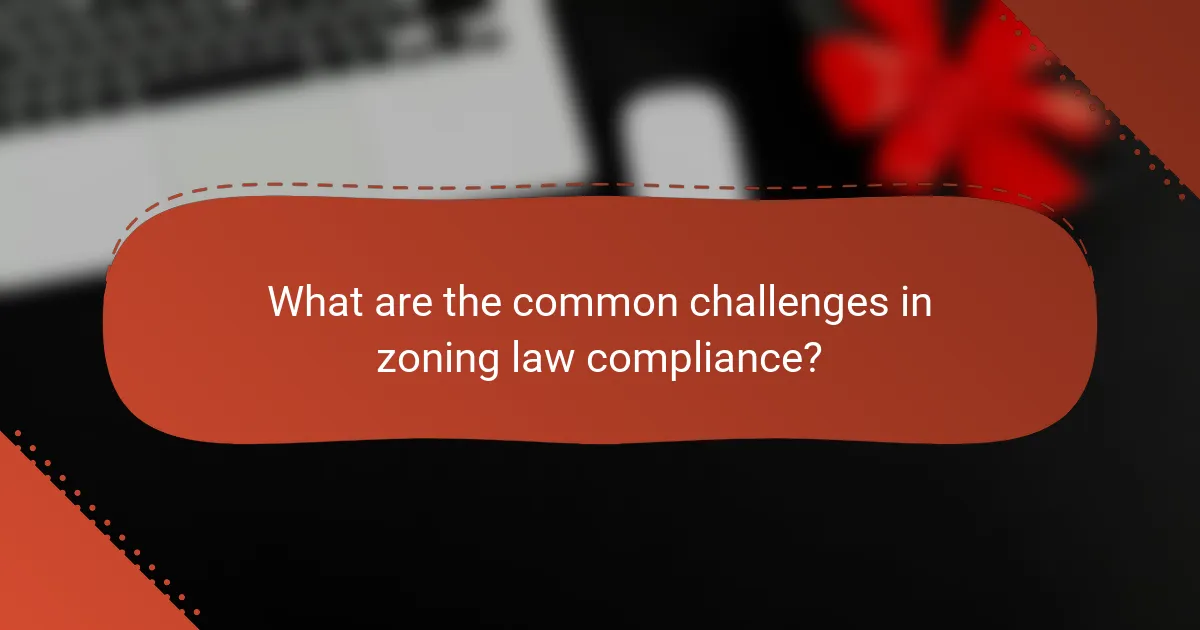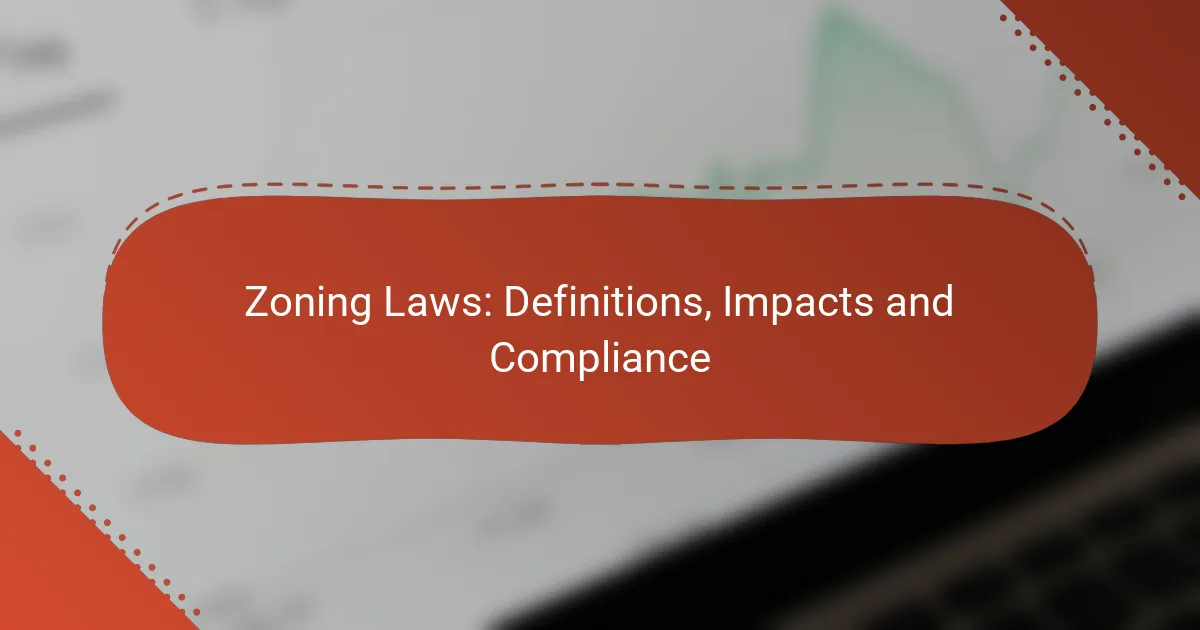Zoning laws are essential regulations that govern land use and development in urban areas, influencing how residential, commercial, and industrial spaces are structured. These laws not only determine the feasibility and design of property projects but also play a vital role in shaping community development and urban planning. Compliance with these regulations is crucial for property owners and developers, as they vary widely by location and dictate specific building and land use requirements.

What are the zoning laws in major US cities?
Zoning laws in major US cities are regulations that dictate how land can be used and developed. These laws vary significantly by location, affecting residential, commercial, and industrial areas, and they play a crucial role in urban planning and community development.
New York City zoning laws
New York City’s zoning laws are among the most complex in the country, designed to manage the city’s dense population and diverse land uses. The city is divided into various zoning districts, each with specific regulations regarding building height, bulk, and use. For example, residential zones may have restrictions on the number of units per building, while commercial zones can dictate the types of businesses allowed.
Developers must navigate the city’s zoning resolution, which includes provisions for special permits and variances. Engaging with the local community board can also be beneficial, as public input often influences zoning decisions.
Los Angeles zoning regulations
Los Angeles zoning regulations are structured to accommodate the city’s sprawling layout and varied neighborhoods. The city employs a system of zoning classifications, including residential, commercial, and industrial, each with distinct requirements. For instance, residential zones may limit the height of buildings and the density of housing units.
Developers should be aware of the city’s Specific Plans, which provide additional guidelines for certain areas. Understanding the local context and engaging with city planners can help streamline the approval process.
Chicago zoning classifications
Chicago’s zoning classifications categorize land into residential, commercial, and manufacturing zones, each with specific rules governing development. The city utilizes a zoning map that outlines these classifications, which can dictate everything from building height to the types of businesses allowed in a given area.
Chicago also offers a zoning variance process for developers seeking exceptions to the standard regulations. It is advisable to consult with the Chicago Department of Planning and Development to ensure compliance and understand any neighborhood-specific requirements.
Houston zoning exemptions
Houston is unique in that it does not have a formal zoning ordinance, allowing for a more flexible approach to land use. However, the city does have regulations that govern land development, such as building codes and land use policies. This lack of zoning can lead to mixed-use developments, but it also requires developers to be aware of other regulations that may affect their projects.
Developers should consider the implications of deed restrictions and local ordinances, which can serve as informal zoning guidelines. Engaging with local neighborhood associations can provide insights into community preferences and potential challenges.
San Francisco zoning restrictions
San Francisco’s zoning restrictions are designed to preserve the city’s unique character and manage its limited space. The city has a detailed zoning map that outlines various districts, each with specific regulations regarding building height, density, and land use. For example, certain areas may have strict height limits to maintain views and historical aesthetics.
Developers must navigate the city’s planning process, which includes public hearings and environmental reviews. Understanding the nuances of the San Francisco Planning Code is essential for compliance and successful project approval.

How do zoning laws impact property development?
Zoning laws significantly influence property development by dictating how land can be used, which directly affects project feasibility and design. These regulations can limit the types of structures that can be built, their size, and their placement on a property, ultimately shaping the development landscape.
Land use restrictions
Land use restrictions define what activities can occur on a property, such as residential, commercial, or industrial uses. These restrictions help maintain community character and prevent incompatible developments. For example, a residential zone may prohibit commercial enterprises, ensuring that neighborhoods remain quiet and family-friendly.
When considering a property for development, it’s crucial to verify the designated land use. Engaging with local planning departments can provide clarity on allowable uses and any potential variances that might be needed.
Building height limitations
Building height limitations restrict how tall structures can be, which can affect both the aesthetic and functional aspects of development. These limits are often set to preserve sightlines, sunlight access, and the overall character of an area. For instance, a downtown area may allow taller buildings, while suburban neighborhoods may impose stricter height controls.
Developers should assess height restrictions early in the planning process to avoid costly redesigns. Understanding the local skyline and surrounding structures can help in making informed decisions about building design and compliance.
Density regulations
Density regulations control the number of units or structures allowed on a given area of land, impacting how many people can live or work in a development. These regulations are crucial for managing infrastructure, traffic, and community resources. For example, a high-density zone may permit multi-family units, while a low-density zone may only allow single-family homes.
When planning a project, consider the density allowances to maximize land use while adhering to local regulations. Engaging with community stakeholders can also provide insights into density preferences and potential pushback.
Setback requirements
Setback requirements dictate how far structures must be from property lines, streets, or other features. These rules are designed to ensure safety, privacy, and aesthetic harmony within neighborhoods. For example, a residential property may require a 10-foot setback from the street, while commercial properties might have different standards.
Understanding setback requirements is essential for site planning and can influence the layout of buildings and outdoor spaces. Always check local zoning codes for specific setback distances to avoid non-compliance and potential fines.

What are the compliance requirements for zoning laws?
Compliance with zoning laws typically involves adhering to local regulations that dictate land use, building specifications, and property development. These requirements can vary significantly by jurisdiction, so it is crucial for property owners and developers to understand the specific rules applicable to their area.
Permitting process
The permitting process is a critical step in ensuring compliance with zoning laws. Property owners must apply for the necessary permits before beginning any construction or significant modifications to their property. This process usually involves submitting detailed plans and documentation to the local zoning authority for review.
Permits can include building permits, occupancy permits, and special use permits, depending on the nature of the project. It’s important to check local regulations for specific requirements, as some areas may have expedited processes for certain types of projects.
Variance applications
A variance application allows property owners to request exceptions to specific zoning regulations. This is often necessary when a proposed project does not fully comply with existing zoning laws, such as setbacks or height restrictions. To obtain a variance, applicants must demonstrate a legitimate need and how the variance will not adversely affect the surrounding area.
The approval process for a variance can be lengthy and may require the submission of additional documentation or plans. It’s advisable to consult with local zoning officials early in the process to understand the likelihood of approval and any potential challenges.
Public hearings
Public hearings are often a part of the zoning compliance process, particularly for significant projects or variance applications. These hearings provide an opportunity for community members to voice their opinions and concerns regarding proposed developments. Property owners should prepare for these hearings by gathering community support and addressing potential objections.
During the hearing, applicants typically present their case, followed by a period for public comments. Understanding local procedures and preparing thoroughly can help facilitate a smoother hearing process.
Enforcement mechanisms
Enforcement mechanisms are in place to ensure compliance with zoning laws. Local authorities may conduct inspections and monitor developments to ensure that projects adhere to approved plans and permits. Violations can lead to fines, orders to cease construction, or even legal action.
Property owners should be proactive in understanding and complying with zoning regulations to avoid enforcement issues. Regular communication with local zoning officials can help clarify any uncertainties and ensure that all requirements are met throughout the development process.

How to navigate zoning law compliance in your area?
Navigating zoning law compliance involves understanding local regulations and ensuring your property use aligns with them. Start by researching your area’s zoning laws, which can vary significantly by location and can impact residential, commercial, and industrial properties.
Consulting local zoning boards
Local zoning boards are essential resources for understanding specific zoning regulations in your area. They provide information on zoning classifications, permissible land uses, and any recent changes to the laws. Engaging with these boards can help clarify your compliance obligations and streamline the permitting process.
When consulting a zoning board, be prepared with specific questions about your property and its intended use. This preparation can lead to more productive discussions and quicker resolutions to any zoning issues you may face.
Hiring zoning attorneys
Hiring a zoning attorney can be beneficial if you encounter complex zoning issues or need assistance with legal compliance. These professionals specialize in zoning laws and can provide guidance on navigating regulations, filing appeals, or obtaining variances. Their expertise can save you time and reduce the risk of costly mistakes.
When selecting a zoning attorney, look for someone with experience in your local area and a strong track record of successful cases. This local knowledge can be invaluable in understanding the nuances of your specific zoning laws.
Utilizing zoning maps
Zoning maps are visual representations of zoning districts and classifications within a municipality. These maps can help you identify the zoning designation of your property and understand the regulations that apply. Familiarizing yourself with these maps is a crucial step in ensuring compliance.
Most local government websites provide access to zoning maps, often with interactive features that allow you to explore different areas. Use these resources to verify your property’s zoning and to research neighboring properties, which can provide insights into potential zoning challenges or opportunities.
Engaging with community stakeholders
Engaging with community stakeholders, such as neighborhood associations and local business groups, can provide valuable insights into zoning issues and community priorities. These stakeholders often have a vested interest in zoning decisions and can offer perspectives that may affect your compliance strategies.
Consider attending community meetings or forums to discuss zoning matters. Building relationships with stakeholders can facilitate smoother interactions with local authorities and help you advocate for your interests effectively.

What are the common challenges in zoning law compliance?
Common challenges in zoning law compliance include navigating complex regulations and addressing neighborhood opposition. These issues can significantly impact development projects and require careful planning and communication to overcome.
Understanding complex regulations
Zoning regulations can be intricate, varying widely by locality and often requiring a deep understanding of legal language. Developers must familiarize themselves with local zoning codes, which dictate land use, building heights, and density restrictions.
To effectively navigate these regulations, it is advisable to consult with zoning experts or legal professionals who specialize in land use. This can help identify potential compliance issues early in the planning process, reducing the risk of costly delays or modifications later on.
Dealing with neighborhood opposition
Neighborhood opposition can pose a significant barrier to zoning law compliance, as local residents may resist changes that affect their community. Engaging with the community early in the project can help address concerns and build support.
Consider hosting informational meetings or workshops to explain the project and gather feedback. Demonstrating how the development aligns with community interests can mitigate opposition and facilitate smoother compliance with zoning requirements.
